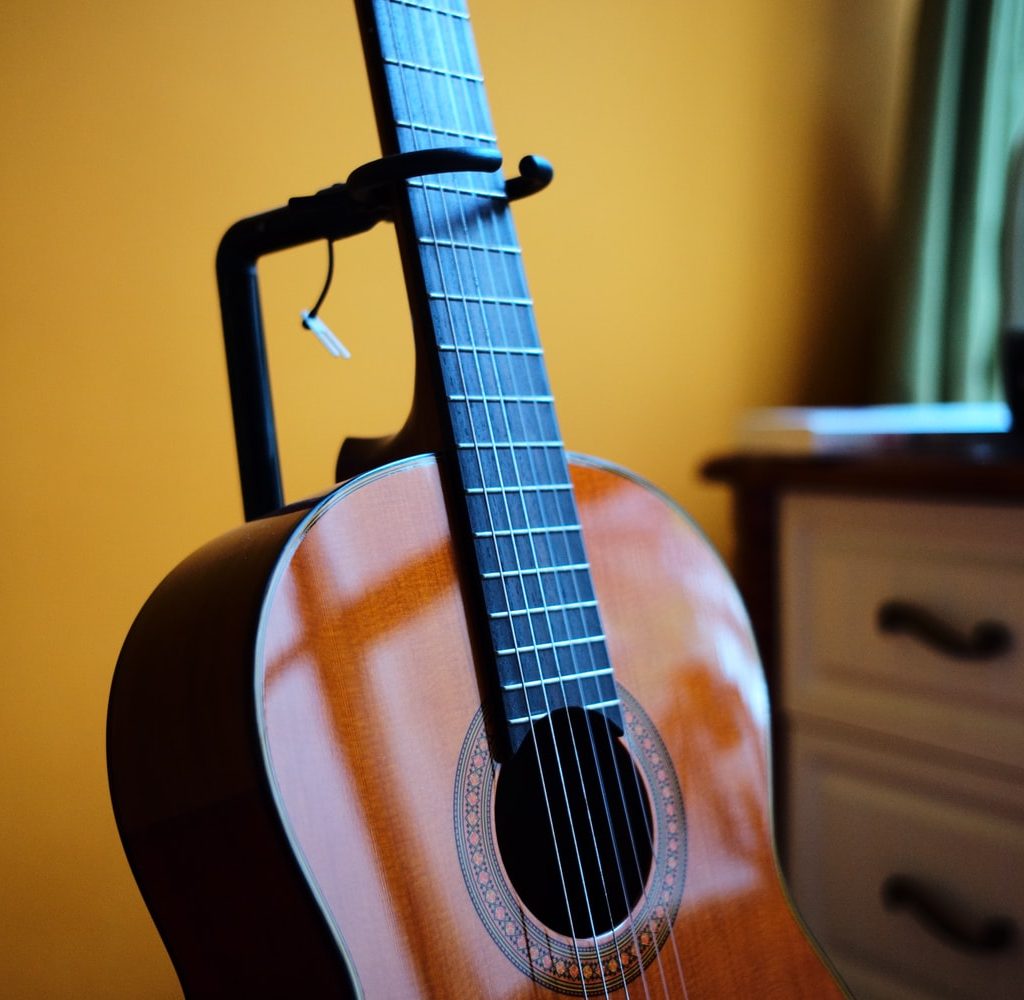Although they might not seem like it, acoustic guitars are very individual instruments. They can easily be finetuned to suit the taste of the guitarist.
This fine-tuning process is what is known as “setting up”. In this article, we are going to show you how to properly set up an acoustic guitar for the best playability.
Antonio Giuliani Acoustic Mahogany Guitar Bundle (DN-1) – Dreadnought Guitar with Case, Strap, Tuner, Strings and Accessories By Kennedy Violins
Before we go on with this article, there are a few things you must be aware of. First, because acoustic guitars vary slightly in measurement, a lot of measurements we are going to be using today are going to be rough estimates and averages.
Second, we are only going to be able to teach you the basics of setting up. Once you’ve done that, you can go on to personalize the guitar however you want.
Table of Contents
Why Should You Set Up Your Acoustic Guitar?
Most affordable guitars(we’re talking guitars around the $100 price point) are factory-made. What separates these affordable guitars from the more expensive ones is the build quality and precision. Most times, those expensive guitars are made by hand and are already fine-tuned before they deliver.
If the guitar you’re buying is factory-made, the tuning is just not going to be precise enough for you to get great quality out of it. So, to get it as close to the more expensive guitars in terms of sound, you would definitely need to tune it.
Old guitars also require a proper set-up from time to time to keep them sounding fresh. Wood changes with time, so a good setup is needed to address that ever-changing nature of wood, as well as, the guitar’s reaction to climatic and string tension changes.
What Exactly Is A Guitar Setup?
A guitar setup is anything from simply changing the strings and the action of the guitar, to correction intonation, saddle height, neck angle, and every single detail about the guitar.
In this article, though, we would not be talking about changing the strings. If you’re trying to do a guitar setup by yourself, you should already know other basic things like changing your strings. If you don’t, you can quickly check out our article on How To Restring A Guitar. Read it, and then come back to this one to continue the setup.
The Tools You’ll Need — How To Set Up An Acoustic Guitar
For a proper guitar setup, you’ll definitely need to invest in some tools. Don’t be too disheartened, though, because once you’ve bought these tools once, they can last you your whole career if you don’t misplace them.
Here’s a quick list of the tools you’ll need:
- 6-inch ruler
- Lemon oil or any mineral-based oil
- Small Phillips screwdriver
- String cutters
- String winder
- Fretboard polish and a small rag.
- A set of automotive feeler gauges (.002 – .025)
- A capo

Setting Up The Guitar — How To Set Up An Acoustic Guitar
Make Sure The Neck Is Straight
The first thing you want to do after restringing your guitar is to ensure that the neck of your guitar is straight. To do this, you’ll need a truss rod. There are two main types of truss rods that acoustic guitars come with.
The more popular one adjusts at the heel of the guitar neck, while the other unpopular one makes adjustments at the headstock. Whichever one your acoustic guitar has would work just fine. They both function using the same principles.
To ensure your guitar neck is straight, you’ll need to remove the truss rod’s cover, if it has any, and then attach a capo to across the 1st fret. If you don’t know what a capo is or how to use it, then we suggest you watch the video below:
Once you’ve attached the capo, press down the 14th fret of the 6th string (the low E string). Now, use the feel gauge to measure the distance between the top and the bottom of the 5th fret on that string. There should be a very small gap usually (.006 inches +/- .002 inches).
If this gap is much less than .006 inches, it can cause a “buzz” effect due to the normal vibration pattern of the strings. It can also cause something called a “fret out” if you have high frets. So, depending on the gap you have, you’ll need to either turn the truss rod in a clockwise direction to tighten the gap too .006 inches, or counter-clockwise direction to loosen it up to .006 inches.
The gap we’re talking about is determined by the thickness of the 1st string (the high E string). Most high E strings are .012 inches in thickness. However, if your’s is a medium gauge string with .13 inches or more in thickness, then you would need slightly more tension from your truss rod in order to counteract the string pull that is much stronger.
Adjusting The Nut
The last thing you want to do is to adjust the nut of your acoustic guitar. To do this, press down on each string just after the 2nd fret. This would enable check the clearance above the first string. This clearance should be adjusted to the approximate thickness of an average index card.
If the clearance is too high, you can reduce it by filing the string grooves with a thin needle file. Once they are adjusted to the right height, it’s best to lubricate the grooves with the mineral oil you got.
This would stop the strings from digging further into the nut as you tighten it. It also doesn’t allow burrs to form against the string. This would prevent the strings from breaking when you’re tuning the guitar.
Saddle Adjustments
At this point, you’re diving much deeper into the set-up. You should not perform this step until every other step above has been performed. To properly adjust the saddle, you’ll need to completely remove it. And removing the saddle means removing the strings. So, you’ll need to restring your guitar when this process is complete.
To remove the saddle, first, you need to remove all the bridge pins and completely unwind the string using a string winder. Once you’ve done this, you can simply slide out the saddle or pry it free using something small and pointy like a needle.
Now adjusting the saddle to properly fit what you want is quite a tricky process. It would be difficult for you to follow without actually seeing what you’re doing. So, we oblige you to watch the video below for a much better, easier to understand, lesson on saddle adjustments.
As he said, this is a very vital process. If you don’t think you can do it by yourself, then you should probably head over to a guitar center to get a professional to do it for you.
Conclusion
Honestly, we think that as a guitarist, you should take your time to learn the process and all the technicalities above. It might seem like a lot now but with time, patience, and a lot of practice, you’ll be able to do this anytime you want.
Think about it like getting a new car. There might be situations where it’s best to send it to a mechanic. However, it’s best you know what does what in the car so if something happens and you just can’t get it to a mechanic, you can at least keep it going for a while before you see the mechanic.
With that said, we leave you to your new great sounding guitar! Adios!
